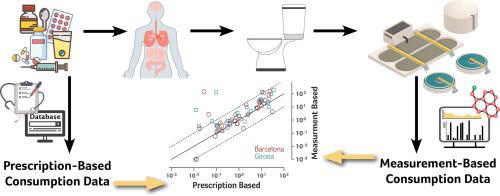Environment International ( IF 11.8 ) Pub Date : 2021-02-09 , DOI: 10.1016/j.envint.2021.106404 M. Escolà Casas , N.S. Schröter , I. Zammit , M. Castaño-Trias , S. Rodriguez-Mozaz , P. Gago-Ferrero , Ll. Corominas

|
While the extent of pharmaceutical consumption within a society/community is of high relevance to its health, economy and general wellbeing, this data is often not readily available. Herein, we strengthen a wastewater–based epidemiology (WBE) approach as a way to track the consumption of pharmaceuticals within the sampled community. This method is less laborious than established questionnaire or databases approaches and allows a higher temporal and spatial resolution. The WBE approach was conducted by sampling influent wastewater from two wastewater treatment plants of different size. A total of 39 targeted compounds were quantified by liquid chromatography coupled with tandem mass spectrometry. The number of prescriptions and the defined daily doses for each prescription was obtained from the reference database of The Catalan Health System to validate the wastewater-based approach. The wastewater sampling and the data inquiry were both executed during the same period (October 2019) and standardised for comparison to treatments per 1,000 inhabitants per day. The back-calculation parameters were improved from previous studies by including the faecal excretion rate of the pharmaceuticals. For prescription only pharmaceuticals, where prescription numbers are expected to be a good estimate of consumption, our WBE approach agreed with 27 out of 32 (<0.7 order of magnitude). Common over-the-counter pharmaceuticals such as acetaminophen, ibuprofen and naproxen showed much higher values for treatments per day per 1,000 inhabitant in wastewater than prescribed, reflecting the usefulness of WBE in obtaining an estimate of the total consumption i.e. with and without a prescription.
中文翻译:

展示基于废水的流行病学追踪城市药品消费的潜力:与在精细空间分辨率下收集的处方数据进行比较
尽管一个社会/社区内的药品消费量与其健康,经济和总体福祉高度相关,但这些数据通常不易获得。在此,我们加强了基于废水的流行病学(WBE)方法,以跟踪抽样社区内药品的消费。这种方法比已建立的调查表或数据库方法省力,并且允许更高的时间和空间分辨率。WBE方法是通过对来自两个不同规模的废水处理厂的进水进行采样来进行的。通过液相色谱-串联质谱法对总共39种目标化合物进行了定量。可从加泰罗尼亚卫生系统的参考数据库中获得处方数量和每个处方的定义每日剂量,以验证基于废水的方法。废水采样和数据查询均在同一时期(2019年10月)进行,并进行了标准化,以便与每天每1000名居民的处理量进行比较。通过包括药物的粪便排泄率,从以前的研究中改进了反算参数。对于仅处方药的药品,预计处方药数量可以很好地估计消费量,因此我们的WBE方法同意32个中的27个(<0.7数量级)。常见的非处方药,例如对乙酰氨基酚,布洛芬和萘普生,每1天内的每日治疗价值更高


























 京公网安备 11010802027423号
京公网安备 11010802027423号